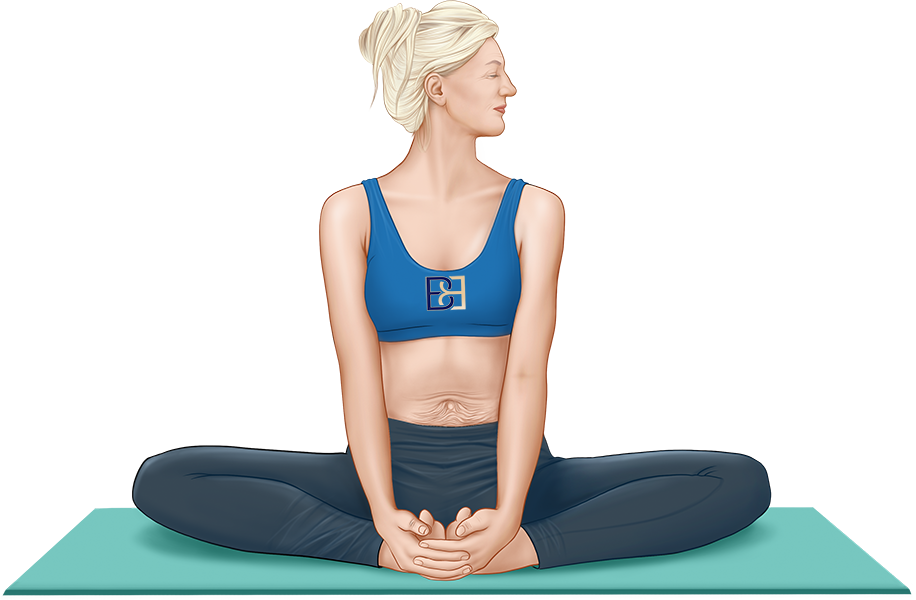Caused by the parallel rectus abdominal muscles separating as the uterus expands, diastasis recti (tummy bulge) is a common condition in pregnant mothers which can cause one to still look pregnant after giving birth. This doesn’t have to be your case.
Book your appointment online now
What Is Diastasis Recti?
Known as “six-pack abs,” the rectus abdominal muscles run vertically along the stomach. Commonly affecting ⅔ of expecting mums, diastasis recti is a condition that causes rectus abdominal muscles to separate during or after pregnancy.

Wondering how these muscles separate? Let me explain.
Rectus abdominal muscles are divided into two; the left and right sides separated by a tissue band running between them known as the linea alba.
During pregnancy, your uterus expands, causing the parallel abdominal muscle bands to stretch. This results in the separation of the linea alba pulling apart. The extent of this separation depends on the uterus expansion. The more expansion, the wider (outwards) the separating tissue band gets.
The same National Library of Medicine study shows that “[p]regnancy and postpartum affect the female body in numerous ways. During this period, women’s bodies tend to undergo hormonal, anatomical, and physiological variations. While these changes provide a feasible environment for the development of the foetus, they also impose a negative influence on the musculoskeletal health of the female body. As a result, women experience unusual musculoskeletal issues in the abdomen after childbirth. One such issue is DRA. It has received much attention in the last two decades among researchers and women. It is a benign condition characterised by the separation of the rectus abdominis muscles.”
After pregnancy, your linea alba can self-heal and ** to its original shape, facilitated by its elasticity property. However, when the uterus expansion is severe, and the linea alba is overstretched, the tissue might lose its elasticity, leaving a gap between the rectus abdominal muscles.
This is diastasis recti.

But how do you know if you have Diastasis Recti? I have prepared a complete guideline in my article, How to Tell if Your Abdominal Muscles Were Torn (Diastasis Recti) During Pregnancy to help you make a preliminary assessment.
Who Develops Diastasis Recti (Muscle Separation)?
Diastasis recti is common in pregnant women, and the chances of experiencing muscle separation in underlying muscles increase if the condition was present in previous pregnancies. Other factors that increase the likelihood of developing diastasis recti after or during pregnancy include;
- Carrying twins or multiple babies
- Poor muscle tone
- Age – mums over the age of 35 are more prone to this condition
Preventing Ab Muscle Separation
Before Pregnancy
My best recommendation for preventing muscle separation during or after giving birth is to ensure you are in good general health and adopt a regime that strengthens your core muscles before pregnancy. The idea is to prepare your body with strong and toned abs for the experience that lies ahead. Just like your physician may have suggested certain vitamins and food, incorporating exercises to prevent pregnancy complications like Diastasis Recti Abdominis into your daily routine will also be extremely beneficial.

During Pregnancy
During the early pregnancy stages, the best way to prevent ab muscle separation is by performing exercises that gently strengthen the core ab muscles.
Any exercises performed during pregnancy should be soft and moderate to ensure your delicate womb stays intact.
For information about exercising after pregnancy, refer to this blog post, Exercising After Abdominoplasty (Tummy Tuck) Surgery
Post-Pregnancy
Diastasis recti is common in pregnant women, affecting over 60% of new mothers. The good news is that it usually resolves by itself after about eight weeks post-delivery. However, the condition can last longer, with 40% of cases resolving six months or more after child delivery.
A study published by PubMed shows that “[a] widening of the linea alba that is greater than 2 cm is referred to as rectus diastasis (RA). This condition is widespread in both pregnant and postpartum women, with a prevalence rate of 70 % in the final trimester of pregnancy, 60 % at 6 weeks after delivery, and 30 % at 12 months.”
The best way to deal with abdominal muscle separation is to strengthen your transversus abdominis and pelvic floor muscles. Here are 11 practical and effective exercises I recommend for you to try. The beauty is that you can do them in the comfort of your home without a personal trainer or gym equipment.
11 Exercises to Help with Diastasis Recti Post-Pregnancy
Below are 11 exercises for diastasis recti abdominis post pregnancy.
1. Dead Bugs

This exercise effectively remedies abdominal muscle separation by working on the deepest abdominal muscle layer, the transverse, to ** its core stability. To put your deep abdominal muscles to work,
- Lie on your back on a flat surface while raising your hand straight in front of you.
- Put your legs up in the air and bend your knees as you mimic sitting on a chair. This will be your original position to begin the exercise.
- Stretch the left leg straight and slowly bring it down. As you do this, get the right arm straight to your right ear.
- Resume the original position and repeat the process. However, stretch the right leg and move your left arm simultaneously.
2. Heel Slide

After completing your dead bug exercise, lie flat on your back on the floor. Your next heel-side exercise aims to strengthen and stabilise your weak abdominal muscles.
Begin the heel slide by retaining your position on the floor and bending your knees; this will be our original position for this exercise. Next, carefully slide out a leg to the front while keeping the foot on the floor the whole time. Return the leg to the original position and slide out the other leg. Keep alternating to keep your core engaged.
3. Bridges

Our next exercise focuses on strengthening your loose pelvic muscles to reduce lower back pain. This exercise is crucial during the early post-pregnancy stages since it alleviates the pain and ** your deep core. Furthermore, the exercise goes beyond and engages your buttocks.
Bridge exercises require lying flat on your mat and placing your legs and feet together, creating a 45-degree angle. Next, put your hands on the ground and bring the hips together to create a “bridge”; this will be your original position. Slowly lift your hips to create a straight line between your knees and shoulders. This will help to squeeze the glute muscles, core, and inner thighs. Hold for about 3 to 5 seconds as you do this, but you can hold longer to make the exercise more effective. Complete 3 sets of 10 to 12 repetitions.
4. Pelvic Tilt

Pelvic tilt helps alleviate the lower back pain caused by DRA and stretches your lower back muscles.
It involves lying flat on your back and bending your knees. Keep your legs apart and your feet flat with your arms flat and straight on your sides. Begin the exercise by bracing your abdomen and tilting the pelvis forward.
As you do this, ensure your lower back stays pressed on the floor. Hold the position for about five seconds. Ensure that you squeeze the glutes and tighten the abdominal muscles. Resume the original position and repeat the exercise.
5. Leg Raises

The Leg Raise exercises focus on your lower abdominal muscles and lengthen and strengthen the hip flexors. This is crucial for ** your core strength and stability. Leg Raise exercises are also most effective during the first weeks after delivery when your abdominal muscles are weakest.
Lie flat on your back and extend both your hands and legs. Also, keep your arms straight by your sides or tuck them beneath the hips to provide additional support. Carefully raise both legs while keeping them together and completely stretched until the sole’s of your feet are parallel to the ceiling.
Lower them and the process. As you do this, ensure that your legs don’t touch the floor as you lower them. Additionally, make sure that your back stays flat on the floor to stabilise your core.
6. Table Tops
Table tops are effective for working and strengthening your deep transversus muscles.
To do this exercise, get on all fours, assuming a table position with your knees and hands placed knee-width and shoulder-width apart. Extend the right arm and left leg so they are parallel to the floor and hold for 2 to 5 seconds. Maintain your core tightness and alternate to the left arm and right leg. Repeat these 10 to 15 times for 3 sets.
If this combination becomes difficult, you can involve just the arms or legs simultaneously.
Still maintaining the 90-degree angle at the hips and the knees, keep the arms straight below the shoulders, extending them so they are parallel with the floor. Hold for 2 to 5 seconds and return to the starting position, then proceed to the other arm. Do the same for the legs and repeat.
The trick to table tops is to ensure controlled and slow movements. As you do this exercise, ensure you are engaging your deep core.
7. Bent Knee Fall-Outs

Here is another exercise that works your transverse and other abdominal muscles. Begin by lying flat on your back with your knees bent. Ensure that your feet stay flat to initiate the normal lower back curve.
Next, tighten the abdominal muscles and slowly lower the left leg. As you do this, ensure the right leg stays bent. It’s important to keep the pelvis stable. Gently return the left leg and repeat the process with the right leg.
8. Kegels

Kegel exercises focus on the pelvic floor muscles, aiming to hold and tighten the muscles responsible for controlling urine flow. The best thing about this exercise is you can do it anywhere.
You can do kegels in two ways: fast mode and slow mode. There is no ideal choice; your best option is one you are comfortable doing.
In slow mode, carefully squeeze the pelvic muscles and hold them for about five seconds. Release the squeeze and repeat that 10 times.
For fast mode, repeat the same procedure, however, do so in ** succession. This way, you’ll be doing 15 to 20 reps at a go.
9. Wall Sits

Start by positioning yourself on a wall. Squat as you lean against the wall and ensure your knees stay 90 degrees and thighs parallel to your floor. Move your arms away from the legs and your stomach closer to the spine. Ensure that your back remains flat against the wall.
Hold your position for about one minute before taking a short break. Allow your abdomen and thighs to relax before resuming your position and repeating the process.
10. Transversus Abdominis Breathing (TVA)

This exercise specifically targets deep transversus abdominal muscles, which might be damaged after childbirth. You can choose to lie or sit down for this exercise. After taking your position, take a deep breath through your nose and shift your attention to your lower abdominal muscles.
Move your navel inwards as you slowly exhale. Keep your focus on your lower abdomen throughout. As you exhale, make a smooth ‘Ssss’ sound to help identify the core muscles to target. As you exhale, you will experience a ** squeeze in your abdomen. You might be doing it wrongly if you don’t feel the squeeze.
11. Clams

Here is an ** and fun exercise that stabilises your core, repairs ab muscles, and engages your buttocks and hips. Begin by lying on your side and slowly bending your knees. As you do this, ensure your feet stay stacked.
Gently open your knees as you remain balanced to engage the core abdominal muscles. Channel your mind to the deep abdominal movements to ensure all deep-lying muscles are engaged.
Take a break and repeat.
Download our infographic: “15 Exercises to Try After Abdominoplasty”
Side Effects of Muscle Separation in the Abdominal Region
Vaginal Delivery Difficulties: One of the commonly experienced side effects of Diastasis Recti Abdominis is vaginal delivery difficulties. When the parallel ab muscles move away from one another, they stretch the connective tissue band reducing the muscle support offered by the band to other body organs, making vaginal delivery challenging.
Hernia: Another rare side effect of diastasis recti is hernia which occurs as a result of the tissues tearing, leading to organs poking out of the created opening.
Constipation, Urine Leakage, and Back Pain: Abdominal muscle separation can also result in constipation, urine leaking, and lower back pain.
Other rare side effects: Pain, poor posture, and excess skin and fat in the abdominal region, which may require surgical intervention to correct.
Exercises to Avoid
Not all exercises focusing on your abdominal muscles will help repair separated muscles in the abdominal region. In fact, some exercises such as planks and crunches can worsen the condition because they create too much pressure, which can be damaging during the early weeks after delivery.
Remedies for Treating DRA

There are various ways to remedy diastasis recti, depending on the extent of the separation among other factors. During your assessment, I will determine the best remedy for your specific condition and whether tummy tuck surgery to repair the separated muscles or remove excess skin from significant weight loss is in your best interest. If we take this route, I expect you to have attained a stable weight, and avoid smoking at least 6 weeks before surgery.
Book your appointment online now
Dr. Bernard’s Final Thoughts

Diastasis Recti should be the least of your concerns during pregnancy. As much as it is common and affects most mothers, the exercises we’ve discussed above aim to reduce linea alba separation, strengthen abdominal muscles, and engage the pelvic floor muscles. These exercises become more effortless the more you practise. However, seek professional advice before beginning any exercise program. You can book a consultative session with me so that we can determine which exercises will work best for you or if abdominoplasty surgery could be warranted post-pregnancy.
References
- Michalska A, Rokita W, Wolder D, Pogorzelska J, Kaczmarczyk K. Diastasis recti abdominis – a review of treatment methods. Ginekol Pol. 2018;89(2):97-101.
- Hall H, Sanjaghsaz H. Diastasis Recti Rehabilitation. 2023 Aug 8.
- Ramirez OM, Ruas E, Dellon AL. “Components separation” method for closure of abdominal-wall defects: an anatomic and clinical study. Plast Reconstr Surg. 1990 Sep;86(3):519-26.
- Hoogeboom TJ, Dronkers JJ, Hulzebos EH, van Meeteren NL. Merits of exercise therapy before and after major surgery. Curr Opin Anaesthesiol. 2014 Apr;27(2):161-6.
- Paul M, Smart TF, Doleman B, Toft S, Williams JP, Lund JN, Phillips BE. A systematic review of the impact of postoperative aerobic exercise training in patients undergoing cosmetic surgery for intra-abdominal cancers. Tech Coloproctol. 2023 Dec;27(12):1169-1181.
- Hayashi K, Janowski A, Lesnak JB, Sluka KA. Preoperative Exercise Has a Modest Effect on Postoperative Pain, Function, Quality of Life, and Complications: A Systematic Review and Meta-Analysis. Phys Ther. 2023 Mar 3;103(3):pzac169.
- Myers JN, Fonda H. The Impact of Fitness on Surgical Outcomes: The Case for Prehabilitation. Curr Sports Med Rep. 2016 Jul-Aug;15(4):282-9.
- Bhatt NR, Sheridan G, Connolly M, Kelly S, Gillis A, Conlon KC, Lane S, Shanahan E, Ridgway PF. Postoperative exercise training is associated with reduced respiratory infection rates and early discharge: A case-control study. Plastic Surgeons. 2017 Jun;15(3):139-146.
- Valkenet K, van de Port IG, Dronkers JJ, de Vries WR, Lindeman E, Backx FJ. The effects of preoperative exercise therapy on postoperative outcome: a systematic review. Clin Rehabil. 2011 Feb;25(2):99-111.





